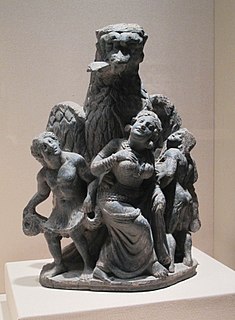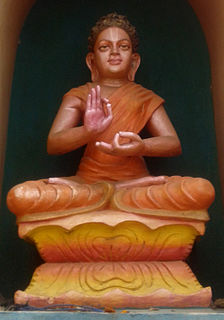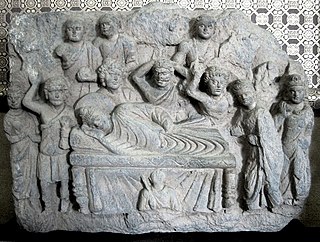 W
WThe Buddha was a philosopher, mendicant, meditator, spiritual teacher, and religious leader who lived in Ancient India. He is revered as the founder of the world religion of Buddhism, and worshipped by most Buddhist schools as the Enlightened One who has transcended Karma and escaped the cycle of birth and rebirth. He taught for around 45 years and built a large following, both monastic and lay. His teaching is based on his insight into duḥkha and the end of dukkha – the state called Nibbāna or Nirvana.
 W
WBahujana sukhaya bahujana hitaya cha is a dictum or aphorism enunciated in the Rigveda in Sanskrit.
 W
WBuddhacharita is an epic poem in the Sanskrit mahakavya style on the life of Gautama Buddha by Aśvaghoṣa, composed in the early second century CE. Of the poem's 28 cantos, the first 14 are extant in Sanskrit complete.
 W
WBuddhism is the world's fourth-largest religion with over 520 million followers, or over 7% of the global population, known as Buddhists. Buddhism encompasses a variety of traditions, beliefs and spiritual practices largely based on original teachings attributed to the Buddha and resulting interpreted philosophies. It originated in ancient India as a Sramana tradition sometime between the 6th and 4th centuries BCE, spreading through much of Asia. Two major extant branches of Buddhism are generally recognized by scholars: Theravāda and Mahāyāna.
 W
WThe Dhammacakkappavattana Sutta is a Buddhist text that is considered by Buddhists to be a record of the first sermon given by Gautama Buddha. The main topic of this sutta is the Four Noble Truths, which refer to and express the basic orientation of Buddhism in a formulaic expression. This sutta also refers to the Buddhist concepts of the Middle Way, impermanence, and dependent origination.
 W
WThe footprint of the Buddha is an imprint of Gautama Buddha's foot or both feet. There are two forms: natural, as found in stone or rock, and those made artificially. Many of the "natural" ones are acknowledged not to be genuine footprints of the Buddha, but rather replicas or representations of them, which can be considered cetiya and also an early aniconic and symbolic representation of the Buddha.
 W
WGaruda's abduction of Queen Kakati is a famous Buddhist tale about the former lives of the Buddha, called a Jataka.
 W
WIn the Vaishnavism sect of Hinduism, the historic Buddha or Gautama Buddha, is considered to be an avatar of the Hindu god Vishnu. Of the ten major avatars of Vishnu, Vaishnavites believe Gautama Buddha to be the ninth and most recent incarnation.
 W
WGaya is of historical significance and is one of the major tourist attractions in the southern part of the state of Bihar. Gaya is 116 kilometres (72 mi) south of Patna, the capital city of Bihar. It is the state's second-largest city, with a population of 470,839, and is the headquarters of Gaya district and Magadh division. The city is surrounded on three sides by small, rocky hills, with the Phalgu River on its eastern side.
 W
WThe Great Renunciation or Great Departure is the traditional term for the departure of Gautama Buddha from his palace at Kapilavastu to live a life as an ascetic. It is called the Great Renunciation because it is regarded as a great sacrifice. Most accounts of this event can be found in post-canonical Buddhist texts from several Buddhist traditions, which are the most complete. These are, however, of a more mythological nature than the early texts. They exist in Pāli, Sanskrit and Chinese language.
 W
WKanthaka was a favourite white horse of length eighteen cubits that was a royal servant of Prince Siddhartha, who later became Gautama Buddha. Siddhartha used Kanthaka in all major events described in Buddhist texts prior to his renunciation of the world. Following the departure of Siddhartha, Kanthaka died of a broken heart.
 W
WThe miracles of Gautama Buddha refers to supernatural feats and abilities attributed to Gautama Buddha by the Buddhist scriptures. The feats are mostly attributed to supranormal powers gained through meditation, rather than divine miracles. Supranormal powers the historic Buddha was said to have possessed and exercised include the six higher knowledges (abhiññā): psychic abilities (iddhi-vidhā), clairaudience (dibba-sota), telepathy (ceto-pariya), recollection of one's own past lives (pubbe-nivāsanussati), seeing the past lives and rebirths of others (dibba-cakkhu), and the extinction of mental intoxicants (āsavakkhaya). Miracles found in Mahayana sutras generally play a more direct role in illustrating certain doctrines than miracles found in non-Mahayana Buddhist texts.
 W
WIn Buddhism, parinirvana is commonly used to refer to nirvana-after-death, which occurs upon the death of someone who has attained nirvana during his or her lifetime. It implies a release from the Saṃsāra, karma and rebirth as well as the dissolution of the skandhas.
 W
WThere are no extant representations of the Buddha represented in artistic form until roughly the 2nd century CE, partly due to the prominence of aniconism in the earliest extant period of Buddhist devotional statuary and bas reliefs. A number of early discourses describe the appearance of the Buddha, and are believed to have served as a model for early depictions. In particular, the "32 signs of a Great Man" are described throughout the Pali Canon, and these are believed to have formed the basis for early representations of the Buddha. These 32 major characteristics are also supplemented by another 80 secondary characteristics (Pali:Anubyanjana).
 W
WPrince Sattva was one of the previous incarnations of Gautama Buddha, according to a jataka story.
 W
WSarnath is a place located 10 kilometres north-east of Varanasi city near the confluence of the Ganges and the Varuna rivers in Uttar Pradesh, India. The Deer Park in Sarnath is where Gautama Buddha first taught the Dharma, and where the Buddhist Sangha came into existence through the enlightenment of Kondanna.
 W
WIn Buddhist texts, Sumedha is a previous life of Gotama Buddha in which he declares his intention to become a Buddha. Buddhist texts describe that this takes place when Gotama Buddha is still a Buddha-to-be. Traditions regard Sumedha's life as the beginning of the spiritual journey leading up to the attainment of Buddhahood by Gotama in his last life, a journey which takes place through many lifetimes. Born in a brahmin family, Sumedha begins to live as an ascetic in the mountains. One day he meets Dīpankara Buddha and offers his own body for him to walk over. During this sacrifice, he makes a vow that he also will be a Buddha in a future lifetime, which is confirmed by Dīpankara through a prophecy.
 W
WThe Twin Miracle, also called the Miracle at Savatthi (Pali), or the Miracle at Śrāvastī (Sanskrit), is one of the miracles of Gautama Buddha. There are two major versions of the story that vary in some details. The Pali account of the miracle can be found in the Dhammapadattakatha and the Sanskrit version in the Pratiharya-sutra. Buddhists believe it was performed seven years after the Buddha's enlightenment, in the ancient Indian city of Savatthi. According to Buddhist texts, during the miracle the Buddha emitted fire from the top half of his body and water from the bottom half of his body simultaneously, before alternating them and then expanding them to illuminate the cosmos. The miracle was performed during a miracle contest between Gautama Buddha and six rival religious teachers, and is considered one of the Ten Indispensable Acts that all Buddhas are to perform during their lives. The miracle itself is said to have been performed twice, with the Buddha performing it once at his home town of Kapilavastu before performing the main miracle at Savatthi. It is considered to have been Gautama Buddha's greatest miracle and something that can only be performed by fully enlightened Buddhas.